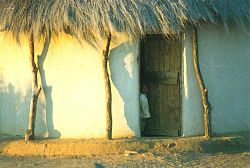- Demographics of Botswana
-
This article is about the demographic features of the population of Botswana, including population density, ethnicity, education level, health of the populace, economic status, religious affiliations and other aspects of the population.
Botswana, like many nations in southern Africa, suffers from a high AIDS infection rates, estimated in a 2002 UN report to be 38.8% for adults. Demographic data from the 2001 Botswana census are included for comparison with 2006 CIA estimates.
CIA World Factbook demographic statistics
The following demographic statistics are from the 2011 CIA World Factbook.
Selected demographic data from the 2001 Botswana census is included for comparison.
Population
- 1,680,863 (2001)
- 2,065,398 (July 2011 est.)
- Note: estimates for this country explicitly take into account the effects of excess mortality due to AIDS; this can result in lower life expectancy, higher infant mortality and death rates, lower population and growth rates, and changes in the distribution of population by age and sex than would otherwise be expected.
Age structure
- 0-14 years: 38.3% (male 319,531/female 309,074)
- 15-64 years: 57.9% (male 460,692/female 488,577)
- 65 years and over: 3.8% (male 23,374/female 38,585) (2006 est.)
- 0-14 years: 34.8% (male 352,399/female 340,058)
- 15-64 years: 61.4% (male 613,714/female 608,003)
- 65 years and over: 3.9% (male 31,155/female 45,547) (2010 est.)
Median age
- Total: 21.7 years
- Male: 21.5 years
- Female: 21.9 years (2009 est.)
Population growth rate
- 1.656% (2011 est.)
Birth rate
- 22.31 births/1,000 population (2011 est.)
Death rate
- 10.57 deaths/1,000 population (2011 est.)
Net migration rate
- 5 migrant(s)/1,000 population (2009 est.) [1]
- note: there is an increasing flow of Zimbabweans into Botswana and South Africa in search of better economic opportunities.
Urbanization
- Urban population: 60% of total population (2008)
- Rate of urbanization: 2.5% annual rate of change (2005-10 est.)
Sex ratio
- At birth: 1.03 male(s)/female
- Under 15 years: 1.04 male(s)/female(s)
- 15-64 years: 1.01 male(s)/female(s)
- 65 years and over: 0.68 male(s)/female(S)
- Total population: 1 male(s)/female(S) (2009 est.)
Infant mortality rate
- Total: 12.59 deaths/1,000 live births
- Male: 13.43 deaths/1,000 live births
- Female: 11.73 deaths/1,000 live births (2009 est.)
Life expectancy at birth
- Total population: 60.93 years
- Male: 61.11 years
- Female: 60.75 years (2010 est.)
Total fertility rate
- 2.5 children born/woman (2011 est.)
HIV/AIDS
Main article: HIV/AIDS in Botswana- Adult prevalence rate: 23.9% (2007 est.)
- People living with HIV/AIDS: 300,000 (2007 est.)
- Deaths due to AIDS: 11,000 (2007 est.)
No national survey of HIV/AIDS prevalency has been done in Botswana.
Major infectious diseases
- Degree of risk: high
- Food or waterborne diseases: bacterial diarrhea, hepatitis A, and typhoid fever
- Vectorborne disease: malaria (2009)
Nationality
- Noun: Motswana (singular), Batswana (plural)
- Adjective: Motswana (singular), Batswana (plural)
Ethnic groups
- Tswana 79%, Kalanga 11%, Basarwa 3%, Kgalagadi 3%, White African 3%, other 1%
Religions
Main article: Religion in BotswanaLanguages
- Tswana 78.2%, Ikalanga 7.9%, Sekgalagadi 2.8%, English 2.1% (official), other 8.6%, unspecified 0.4% (2001 census)
Literacy
- Definition: age 15 and over can read and write
- Total population: 81.2%
- Male: 80.4%
- Female: 81.8% (2007 est.)
Education expenditure
- 8.7% of total GDP (2007)
References
 This article incorporates public domain material from the CIA World Factbook document "2009 edition".
This article incorporates public domain material from the CIA World Factbook document "2009 edition".- Botswana Demographics 2001 Central Statistics Office (Botswana), Census and Demographic Statistics for the year 2001.
Demographics of Africa Sovereign
states- Algeria
- Angola
- Benin
- Botswana
- Burkina Faso
- Burundi
- Cameroon
- Cape Verde
- Central African Republic
- Chad
- Comoros
- Democratic Republic of the Congo
- Republic of the Congo
- Côte d'Ivoire (Ivory Coast)
- Djibouti
- Egypt
- Equatorial Guinea
- Eritrea
- Ethiopia
- Gabon
- The Gambia
- Ghana
- Guinea
- Guinea-Bissau
- Kenya
- Lesotho
- Liberia
- Libya
- Madagascar
- Malawi
- Mali
- Mauritania
- Mauritius
- Morocco
- Mozambique
- Namibia
- Niger
- Nigeria
- Rwanda
- São Tomé and Príncipe
- Senegal
- Seychelles
- Sierra Leone
- Somalia
- South Africa
- South Sudan
- Sudan
- Swaziland
- Tanzania
- Togo
- Tunisia
- Uganda
- Zambia
- Zimbabwe
States with limited
recognition- Sahrawi Arab Democratic Republic
- Somaliland
Dependencies and
other territories- Canary Islands / Ceuta / Melilla / Plazas de soberanía (Spain)
- Madeira (Portugal)
- Mayotte / Réunion (France)
- Saint Helena / Ascension Island / Tristan da Cunha (United Kingdom)
- Western Sahara
Categories:
Wikimedia Foundation. 2010.



